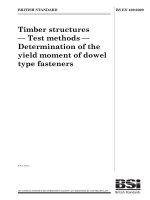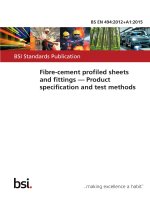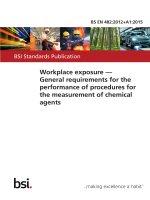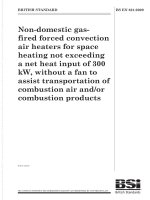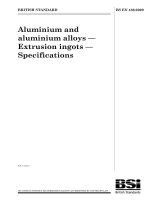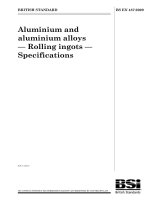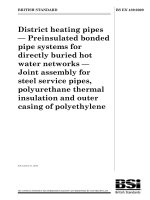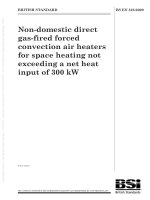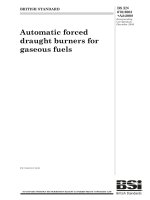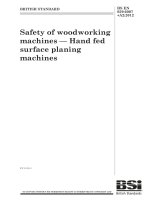Bsi bs en 62080 2009 + a2 2015
Bạn đang xem bản rút gọn của tài liệu. Xem và tải ngay bản đầy đủ của tài liệu tại đây (2.29 MB, 84 trang )
BS EN 62080:2009+A2:2015
BS EN 62080:2009
BSI Standards Publication
Sound signalling devices for
household and similar
purposes
BS EN 62080:2009+A2:2015
BRITISH STANDARD
National foreword
This British Standard is the UK implementation of EN 62080:2009+A2:2015.
It is identical to IEC 62080:2001, incorporating amendment 1:2008 and
amendment 2:2015. It supersedes BS EN 62080:2009, which will be
withdrawn on 22 May 2018.
The start and finish of text introduced or altered by amendment is
indicated in the text by tags. Tags indicating changes to IEC text carry
the number of the IEC amendment. For example, text altered by IEC
amendment 1 is indicated by .
The UK participation in its preparation was entrusted to Technical
Committee PEL/23, Electrical accessories.
A list of organizations represented on this committee can be obtained
on request to its secretary.
This publication does not purport to include all the necessary provisions
of a contract. Users are responsible for its correct application.
© The British Standards Institution 2015.
Published by BSI Standards Limited 2015
ISBN 978 0 580 86740 8
ICS 29.120.99
Compliance with a British Standard cannot confer immunity from
legal obligations.
This British Standard was published under the authority of the Standards
Policy and Strategy Committee on 31 March 2010.
Amendments/corrigenda issued since publication
Date
Text affected
31 December 2015
Implementation of IEC amendment 2:2015 with
CENELEC endorsement A2:2015
BS EN 62080:2009+A2:2015
BS EN 62080:2009
EUROPEAN STANDARD
EN 62080:2009+A2
62080
NORME EUROPÉENNE
EUROPÄISCHE NORM
September
2015
December 2009
ICS 29.120.99
English version
Sound signalling devices for household and similar purposes
(IEC 62080:2001 + A1:2008)
Dispositifs de signalisation sonore
pour usage domestique et analogue
(CEI 62080:2001 + A1:2008)
Akustische Signalgeber für den Haushalt
und ähnliche Zwecke
(IEC 62080:2001 + A1:2008)
This European Standard was approved by CENELEC on 2009-10-01. CENELEC members are bound to comply
with the CEN/CENELEC Internal Regulations which stipulate the conditions for giving this European Standard
the status of a national standard without any alteration.
Up-to-date lists and bibliographical references concerning such national standards may be obtained on
application to the Central Secretariat or to any CENELEC member.
This European Standard exists in three official versions (English, French, German). A version in any other
language made by translation under the responsibility of a CENELEC member into its own language and notified
to the Central Secretariat has the same status as the official versions.
CENELEC members are the national electrotechnical committees of Austria, Belgium, Bulgaria, Cyprus, the
Czech Republic, Denmark, Estonia, Finland, France, Germany, Greece, Hungary, Iceland, Ireland, Italy, Latvia,
Lithuania, Luxembourg, Malta, the Netherlands, Norway, Poland, Portugal, Romania, Slovakia, Slovenia, Spain,
Sweden, Switzerland and the United Kingdom.
CENELEC
European Committee for Electrotechnical Standardization
Comité Européen de Normalisation Electrotechnique
Europäisches Komitee für Elektrotechnische Normung
Central Secretariat: Avenue Marnix 17, B - 1000 Brussels
© 2009 CENELEC -
All rights of exploitation in any form and by any means reserved worldwide for CENELEC members.
Ref. No. EN 62080:2009 E
62080:2009+A2:2015
BS BS
ENEN
62080:2009
EN 62080:2009+A2:2015
EN 62080:2009
–2–
-2-
Foreword
The text of the International Standard IEC 62080:2001 and its amendment 1:2008, prepared by IEC TC 23
Electrical accessories, was submitted to the Unique Acceptance Procedure and was approved by CENELEC
as EN 62080 on 2009-10-01.
The following dates were fixed:
–
–
latest date by which the EN has to be implemented
at national level by publication of an identical
national standard or by endorsement
(dop)
2010-10-01
latest date by which the national standards conflicting
with the EN have to be withdrawn
(dow)
2012-10-01
Annex ZA has been added by CENELEC.
__________
Endorsement notice
The text of the International Standard IEC 62080:2001 + A1:2008 was approved by CENELEC as a
European Standard without any modification.
__________
EN 62080:2009/A2:2015
Foreword
to amendment
European
foreword A2
The text of document 23/705/FDIS, future edition 1 of IEC 62080:2009/A2, prepared by IEC/TC 23
"Electrical accessories" was submitted to the IEC-CENELEC parallel vote and approved by CENELEC as
EN 62080:2009/A2:2015.
The following dates are fixed:
•
•
latest date by which the document has
to be implemented at national level by
publication of an identical national
standard or by endorsement
latest date by which the national
standards conflicting with the
document have to be withdrawn
(dop)
2016-02-22
(dow)
2018-05-22
Attention is drawn to the possibility that some of the elements of this document may be the subject of
patent rights. CENELEC [and/or CEN] shall not be held responsible for identifying any or all such patent
rights.
Endorsement notice
The text of the International Standard IEC 62080:2009/A2:2015 was approved by CENELEC as a
European Standard without any modification.
–3–
-3-
BS EN 62080:2009+A2:2015
BS EN 62080:2009
EN 62080:2009+A2:2015
EN 62080:2009
Annex ZA
(normative)
Normative references to international publications
with their corresponding European publications
The following referenced documents are indispensable for the application of this document. For dated
references, only the edition cited applies. For undated references, the latest edition of the referenced
document (including any amendments) applies.
NOTE When an international publication has been modified by common modifications, indicated by (mod), the relevant EN/HD applies.
Publication
Year
Title
EN/HD
Year
IEC 60065
(mod)
1998
Audio, video and similar electronic apparatus Safety requirements
EN 60065
1998
1)
IEC 60068-2-32
1975
Environmental testing Part 2: Tests - Test Ed: Free fall
EN 60068-2-32
1993
2)
IEC 60068-2-75
1997
Environmental testing Part 2-75: Tests - Test Eh: Hammer tests
EN 60068-2-75
1997
IEC 60083
1997
Plugs and socket-outlets for domestic and
similar general use standardized in member
countries of IEC
-
-
IEC 60085
1984
Thermal evaluation and classification of
electrical insulation
HD 566 S1
1990
3)
IEC 60112
1979
Method for determining the comparative and
the proof tracking indices of solid insulating
materials under moist conditions
HD 214 S2
1980
4)
IEC 60127
series
Miniature fuses
EN 60127
series
IEC 60212
1971
Standard conditions for use prior to and during
the testing of solid electrical insulating
materials
HD 437 S1
1984
IEC 60216
series
Electrical insulating materials - Thermal
endurance properties
EN 60216
series
IEC 60227
series
Polyvinyl chloride insulated cables of rated
voltages up to and including 450/750 V
-
5)
-
IEC 60245
series
Rubber insulated cables - Rated voltages
up to and including 450/750 V
-
6)
-
IEC 60317
series
Specifications for particular types of winding
wires
EN 60317
series
IEC 60320
series
Appliance couplers for household and similar
general purposes
EN 60320
series
1)
2)
3)
4)
5)
6)
EN 60065 is superseded by EN 60065:2002, which is based on IEC 60065:2001, mod.
EN 60068-2-32 is superseded by EN 60068-2-31:2008, which is based on IEC 60068-2-31:2008.
HD 566 S1 was superseded by EN 60085:2004, which is itself superseded by EN 60085:2008, based on IEC 60085:2007.
HD 214 S1 is superseded by EN 60112:2003, which is based on IEC 60112:2003.
The HD 21 series, which is related to, but not directly equivalent with the IEC 60227 series, applies instead.
The HD 22 series, Cables of rated voltages up to and including 450/750 V and having cross-linked insulation, which is related to, but
not directly equivalent with the IEC 60245 series, applies instead.
62080:2009+A2:2015
BS BS
ENEN
62080:2009
EN 62080:2009+A2:2015
EN 62080:2009
Publication
Year
IEC 60384-14
1993
IEC 60417
–4–
-4-
Title
EN/HD
Year
Fixed capacitors for use in electronic
equipment Part 14: Sectional specification: Fixed
capacitors for electromagnetic interference
suppression and connection
to the supply mains
-
-
database
Graphical symbols for use on equipment
-
-
IEC 60529
1989
Degrees of protection provided by enclosures
(IP Code)
EN 60529
+ corr. May
1991
1993
IEC 60664-1
1992
Insulation coordination for equipment within
low-voltage systems Part 1: Principles, requirements and tests
EN 60664-1
2003
8)
IEC 60664-3
-
Insulation coordination for equipment within
low-voltage systems Part 3: Use of coating, potting or moulding for
protection against pollution
EN 60664-3
2003
10)
IEC 60670
(mod)
series
Boxes and enclosures for electrical
accessories for household and similar fixed
electrical installations
EN 60670
series
IEC 60695-2-1
all
sheets
Fire hazard testing Part 2: Test methods - Section 1: Glow-wire
test methods
EN 60695-2-1
IEC 60730
(mod)
series
Automatic electrical controls for household
and similar use
EN 60730
series
IEC 60998
(mod)
series
Connecting devices for low voltage circuits
for household and similar purposes
EN 60998
series
IEC 61000-2-2
1990
Electromagnetic compatibility (EMC) Part 2: Environment - Section 2: Compatibility
levels for low-frequency conducted
disturbances and signalling in public
low-voltage power supply systems
-
-
IEC 61000-3-2
(mod)
2000
Electromagnetic compatibility (EMC) Part 3-2: Limits - Limits for harmonic current
emissions (equipment input current up to and
including 16 A per phase)
EN 61000-3-2
2000
13)
IEC 61000-3-3
1994
Electromagnetic compatibility (EMC) Part 3-3: Limits - Limitation of voltage
fluctuations and flicker in low-voltage supply
systems for equipment with rated
current ≤ 16 A
EN 61000-3-3
+ corr. July
1995
1997
14)
IEC 61000-4-2
1995
Electromagnetic compatibility (EMC) Part 4-2: Testing and measurement
techniques - Electrostatic discharge immunity
test
EN 61000-4-2
1995
15)
7)
8)
9)
10)
11)
12)
13)
14)
15)
7)
9)
12)
11)
all
sheets
IEC 60384-14 is superseded by IEC 60384-14:2005, which is harmonized as EN 60384-14:2005.
EN 60664-1 is superseded by EN 60664-1:2007, which is based on IEC 60664-1:2007.
Undated reference.
Valid edition at date of issue.
EN 60695-2-1/0 to 1/3 are superseded by EN 60695-2-10:2001 to EN 60695-2-13:2001, which are based on IEC 60695-2-10:2000
to IEC 60695-2-13:2000.
IEC 61000-2-2 is superseded by IEC 61000-2-2:2002, which is harmonized as EN 61000-2-2:2002.
EN 61000-3-2 is superseded by EN 61000-3-2:2006, which is based on IEC 61000-3-2:2005.
EN 61000-3-3 is superseded by EN 61000-3-3:2008, which is based on IEC 61000-3-3:2008.
EN 61000-4-2 is superseded by EN 61000-4-2:2009, which is based on IEC 61000-4-2:2008.
–5–
-5-
BS EN 62080:2009+A2:2015
BS EN 62080:2009
EN 62080:2009+A2:2015
EN 62080:2009
Publication
Year
Title
EN/HD
Year
IEC 61000-4-3
(mod)
1995
Electromagnetic compatibility (EMC) Part 4-3: Testing and measurement
techniques - Radiated, radio-frequency,
electromagnetic field immunity test
EN 61000-4-3
1996
16)
IEC 61000-4-4
1995
Electromagnetic compatibility (EMC) Part 4-4: Testing and measurement
techniques - Electrical fast transient/burst
immunity test
EN 61000-4-4
1995
17)
IEC 61000-4-5
+ corr. October
1995
1995
Electromagnetic compatibility (EMC) Part 4-5: Testing and measurement
techniques - Surge immunity test
EN 61000-4-5
1995
18)
IEC 61000-4-6
1996
Electromagnetic compatibility (EMC) Part 4-6: Testing and measurement
techniques - Immunity to conducted
disturbances, induced by radio-frequency
fields
EN 61000-4-6
1996
19)
IEC 61000-4-11
1994
Electromagnetic compatibility (EMC) Part 4-11: Testing and measurement
techniques - Voltage dips, short interruptions
and voltage variations immunity tests
EN 61000-4-11
1994
20)
IEC 61558-1
(mod)
1997
Safety of power transformers, power supply
units and similar Part 1: General requirements and tests
EN 61558-1
+ A11
1997
2003
21)
CISPR 14
series
Electromagnetic compatibility - Requirements
for household appliances, electric tools
and similar apparatus
EN 55014
series
ISO 1456
1988
22)
Metallic coatings - Electrodeposited coatings
of nickel plus chromium and of copper plus
nickel plus chromium
-
-
ISO 2081
1986
23)
Metallic coatings - Electroplated coatings
of zinc on iron or steel
-
-
ISO 2093
1986
Electroplated coatings of tin - Specification
and test methods
-
-
16)
17)
18)
19)
20)
21)
22)
23)
EN 61000-4-3 is superseded by EN 61000-4-3:2002, which is based on IEC 61000-4-3:2002.
EN 61000-4-4 is superseded by EN 61000-4-4:2004, which is based on IEC 61000-4-4:2004.
EN 61000-4-5 is superseded by EN 61000-4-5:2006, which is based on IEC 61000-4-5:2005.
EN 61000-4-6 was superseded by EN 61000-4-6:2007, which is itself superseded by EN 61000-4-6:2009, based on
IEC 61000-4-6:2008.
EN 61000-4-11 is superseded by EN 61000-4-11:2004, which is based on IEC 61000-4-11:2004.
EN 61558-1 is superseded by EN 61558-1:2005, which is based on IEC 61558-1:2005.
ISO 1456:1988 is superseded by ISO 1456:2009, which is harmonized as EN ISO 1456:2009.
ISO 2081:1986 is superseded by ISO 2081:2008, which is harmonized as EN ISO 2081:2008.
BS EN 62080:2009+A2:2015
EN 62080:2009+A2:2015
–6–
–2–
BS EN 62080:2009
EN 62080:2009
CONTENTS
1
Scope ...............................................................................................................................68
2
Normative references........................................................................................................68
3
Definitions ........................................................................................................................8
10
4
14
General requirements ..................................................................................................... 12
5
14
General notes on tests .................................................................................................... 12
6
15
Classification .................................................................................................................. 13
7
16
Marking .......................................................................................................................... 14
8
19
Protection against electric shock ..................................................................................... 17
9
19
Constructional requirements ........................................................................................... 17
24
10 Normal operation ............................................................................................................ 22
25
11 Temperature rise ............................................................................................................ 23
29
12 Abnormal conditions ....................................................................................................... 27
13 Resistance to ageing, protection against ingress of solid objects and against
30
harmful ingress of water and to humidity ......................................................................... 28
33
14 Insulation resistance and dielectric strength .................................................................... 31
36
15 Mechanical strength........................................................................................................ 34
41
16 Resistance to heat .......................................................................................................... 39
42
17 Internal wiring ................................................................................................................. 40
42
18 Components ................................................................................................................... 40
43
19 Terminals ....................................................................................................................... 41
43
20 Flexible cables and their connection................................................................................ 41
49
21 Provision for earthing ...................................................................................................... 47
49
22 Screws, current-carrying parts and connections .............................................................. 47
51
23 Creepage distances and clearances ................................................................................ 49
53
24 Resistance of insulating material to abnormal heat and to fire ......................................... 51
54
25 Resistance to rusting ...................................................................................................... 52
54
26 EMC requirements .......................................................................................................... 52
Annex A (normative)
66
Electronic devices .............................................................................. 64
Annex B (normative)
69
EMC requirements .............................................................................. 67
Annex C (normative)
74
Measurement of creepage distances and clearances .......................... 71
57
Figure 1 – Examples of different types of screws ................................................................... 55
58
Figure 2 – Standard test finger .............................................................................................. 56
59
Figure 3 - Arrangement for test on covers or cover-plates ...................................................... 57
Figure 4 – Gauge (thickness: about 2 mm) for the verification of the outline of covers
and cover-plates ................................................................................................................... 59
57
Figure 5 – Examples of application of the gauge of figure 4 on covers screwlessly fixed
60
on a mounting surface or supporting surface ......................................................................... 58
BS EN 62080:2009
EN 62080:2009
–7–
BS EN 62080:2009+A2:2015
EN 62080:2009+A2:2015
–3–
Figure 6 – Examples of application of the gauge of figure 4 in accordance with the
61
requirements ......................................................................................................................... 59
62
Figure 7 – Void ..................................................................................................................... 60
62
Figure 8 – Sketch showing the direction of application of the gauge of figure 7 ...................... 60
Figure 9 – Ball-pressure apparatus ........................................................................................ 63
61
63
Figure 10 – Flexing test apparatus ........................................................................................ 61
64
Figure 11 – Test pins ............................................................................................................ 62
64
Figure 12 – Test wall ............................................................................................................. 62
65
Figure 13 – Diagrammatic representation .............................................................................. 63
Table 1 – Force to be applied to covers, cover-plates, or actuating members whose
21
fixing are not dependent on screws ....................................................................................... 19
25
Table 2 – Torque to be applied to screws and connections .................................................... 23
28
Table 3 – Values of maximum temperature rise ..................................................................... 26
29
Table 4 – Temperature limits ................................................................................................. 27
Table 5 – Minimum values of insulation resistance for additive insulation protected
33
devices and earth protected devices ...................................................................................... 31
Table 6 – Minimum values of insulation resistance for installation protected devices .............. 34
32
34
Table 7a – Test voltages for devices having a rated voltage not exceeding 130 V .................. 32
35
Table 7b – Test voltages for devices having a rated voltage exceeding 130 V ........................ 33
36
Table 8 – Test voltages ......................................................................................................... 34
38
Table 9 – Pull force on pins ................................................................................................... 36
39
Table 10 – Torques for verification of the mechanical resistance of the screwed glands ......... 37
45
Table 11 – Pull force and torque............................................................................................ 43
Table 12 – Minimum clearances ............................................................................................ 52
50
52
Table 13a – Creepage distances of basic and supplementary insulation................................. 50
52
Table 13b – Creepage distances of reinforced insulation ....................................................... 50
69
Table B.1 – Tests requirements and levels according to the family of the device .................... 67
BS EN 62080:2009+A2:2015
EN 62080:2009+A2:2015
–8–
–6–
BS EN 62080:2009
EN 62080:2009
SOUND SIGNALLING DEVICES
FOR HOUSEHOLD AND SIMILAR PURPOSES
1
Scope
!This International Standard applies to sound signalling devices with integral enclosures or to
sound signalling devices intended to be fitted into or supplied with enclosures according to
IEC 60670 intended for household and similar purposes with rated voltages not exceeding 250
V a.c. or 250 V d.c. and with rated power inputs not exceeding 100 VA. In these sound
signalling devices an indicating light having a rated input power not exceeding 10 VA may
also be incorporated. "
These products are designated as "devices" throughout the remainder of the text.
This standard applies to fixed, portable and plug-in devices for indoor or outdoor use.
In locations where special conditions prevail, special constructions may be required.
NOTE 1 This standard or parts of it may be used as a guide for sound signalling devices having a voltage less
than 50 V a.c. or 75 V d.c. Additional requirements for sound signalling devices having a voltage less than
50 V a.c. or 75 V d.c. are under consideration.
NOTE 2
2
This standard does not cover the radio transmitting or receiving functions.
Normative references
The following referenced documents are indispensable for the application of this document. For
dated references, only the edition cited applies. For undated references, the latest edition of
the referenced document (including any amendments) applies.
IEC 60065:1998, Audio, video and similar electronic apparatus – Safety requirements
IEC 60068-2-32:1975, Environmental testing – Part 2: Tests. Test Ed: Free fall (Procedure 1)
IEC 60068-2-75:1997, Environmental testing – Part 2-75: Tests. Test Eh: Hammer tests
IEC 60083:1997, Plugs and socket-outlets for domestic and similar general use standardized in
member countries of IEC
IEC 60085:1984, Thermal evaluation and classification of electrical insulation
IEC 60112:1979, Method for determining the comparative and the proof tracking indices of solid
insulating materials under moist conditions
IEC 60127 (all parts), Miniature fuses
IEC 60212:1971, Standard conditions for use prior to and during the testing of solid electrical
insulating materials
IEC 60216 (all parts), Guide for the determination of thermal endurance properties of electrical
insulating materials
IEC 60227 (all parts), Polyvinyl chloride insulated cables of rated voltages up to and including
450/750 V
IEC 60245 (all parts), Rubber insulated cables – Rated voltages up to and including 450/750 V
BS EN 62080:2009
EN 62080:2009
–9–
BS EN 62080:2009+A2:2015
EN 62080:2009+A2:2015
–7–
IEC 60317 (all parts), Specifications for particular types of winding wires
IEC 60320 (all parts), Appliance couplers for household and similar general purposes
IEC 60384-14:1993, Fixed capacitors for use in electronic equipment – Part 14: Sectional
specification: Fixed capacitors for electromagnetic interference suppression and connection to
the supply mains
IEC 60417 (all parts), Graphical symbols for use on equipment
IEC 60529:1989, Degrees of protection provided by enclosures (IP Code)
IEC 60664-1:1992, Insulation coordination for equipment within low-voltage systems – Part 1:
Principles, requirements and tests
IEC 60664-3, Insulation coordination for equipment within low-voltage systems – Part 3: Use of
coatings to achieve insulation coordination of printed board assemblies
IEC 60670, General requirements for enclosures for accessories for household and similar
fixed-electrical installations
IEC 60695-2-1 (all sheets) Fire hazard testing – Part 2: Test methods – Section 1: Glow-wire
test and guidance
IEC 60730 (all parts), Automatic electrical controls for household and similar use
IEC 60998 (all parts), Connecting devices for low-voltage circuits for household and similar
purposes
IEC 61000-2-2:1990, Electromagnetic compatibility (EMC) – Part 2: Environment – Section 2:
Compatibility levels for low-frequency conducted disturbances and signalling in public lowvoltage power supply systems
IEC 61000-3-2:2000, Electromagnetic compatibility (EMC) – Part 3-2: Limits – Limits for
harmonic current emissions (equipment input current ≤ 16 A per phase)
IEC 61000-3-3:1994, Electromagnetic compatibility (EMC) – Part 3: Limits – Section 3:
Limitation of voltage fluctuation and flicker in low-voltage supply systems for equipment with
rated current ≤ 16 A
IEC 61000-4-2:1995, Electromagnetic compatibility (EMC) – Part 4: Testing and measurement
techniques – Section 2: Electrostatic discharge immunity test. Basic EMC Publication
IEC 61000-4-3:1995, Electromagnetic compatibility (EMC) – Part 4: Testing and measurement
techniques – Section 3: Radiated, radio-frequency, electromagnetic field immunity test
IEC 61000-4-4:1995, Electromagnetic compatibility (EMC) – Part 4: Testing and measurement
techniques – Section 4: Electrical fast transient/burst immunity test. Basic EMC Publication
IEC 61000-4-5:1995, Electromagnetic compatibility (EMC) – Part 4: Testing and measurement
techniques – Section 5: Surge immunity test
IEC 61000-4-6:1996, Electromagnetic compatibility (EMC) – Part 4: Testing and measurement
techniques – Section 6: Immunity to conducted disturbances, induced by radio-frequency fields
IEC 61000-4-11:1994, Electromagnetic compatibility (EMC) – Part 4: Testing and measuring
techniques – Section 11: Voltage dips, short interruptions and voltage variations immunity tests
IEC 61558-1:1997, Safety of power transformers, power supply units and similar – Part 1:
General requirements and tests
BS EN 62080:2009+A2:2015
EN 62080:2009+A2:2015
– 10 –
–8–
BS EN 62080:2009
EN 62080:2009
CISPR 14 (all parts), Electromagnetic compatibility – Requirements for household appliances,
electric tools and similar apparatus
ISO 1456:1988, Metallic coatings – Electrodeposited coatings of nickel plus chromium and of
copper plus nickel plus chromium
ISO 2081:1986, Metallic coatings – Electroplated coatings of zinc on iron or steel
ISO 2093:1986, Electroplated coatings of tin – Specification and test methods
3
Definitions
For the purpose of this International Standard, the following definitions apply.
NOTE
Where the terms “voltage” and “current” are used, they imply r.m.s. values unless otherwise specified.
3.1
sound signalling device
electromechanical or electronic device which emits an audible sound when activated
NOTE The activation may be produced by manual or automatic means, and where transmission or the activation
signal may be through conductors or by radio or any other transmission means.
3.2
type D device
device where the sound output continues in proportion to the duration of operation of the
control
3.3
type R device
3.3.1
type R1 device
device where the first sound note is created by the initial operation of the control and a second
note is created on the release of the control
3.3.2
type R2 device
device where the sound output is created by the initial operation of the control and where the
period of sound output continues for the designed duration irrespective of the condition of the
control
3.4
enclosure
part providing protection of equipment against certain external influences, and in any direction,
protection against direct contact
[3.1 of IEC 60529]
3.5
fixed device
device which is intended to be permanently connected to a power supply, and to be used when
fastened to a support
NOTE
A support may be a permanent part of a building, an appliance, etc.
3.6
portable device
device intended to be connected to, or integral with, flexible cable(s), and which can easily be
moved from one place to another while connected to the power supply
BS EN 62080:2009
EN 62080:2009
– 11 –
BS EN 62080:2009+A2:2015
EN 62080:2009+A2:2015
–9–
3.7
plug-in device
device provided with plug pins and which relies upon insertion into a socket-outlet for its power
supply
3.8
intermittent operation
sequence of cycles of operation with a specified ON period and specified OFF period
3.9
continuous operation
operation for an unlimited period
3.10
rated voltage
voltage assigned to the device by the manufacturer
3.11
rated voltage range
range of voltages assigned to the device by the manufacturer, expressed by its upper and
lower limits
3.12
ELV (extra low voltage)
voltage supplied from a source within the device which does not exceed 50 V a.c. or 120 V
ripple free d.c. between conductors or between conductors or earth when the device is supplied
at rated voltage
3.13
SELV (safety extra-low voltage)
voltage not exceeding 50 V a.c. or 120 V ripple free d.c. between conductors or between
conductors or earth in a circuit which is isolated from the supply by means such as a safety
isolating transformer
NOTE 1 Maximum voltages lower than 50 V a.c. on 120 V ripple free d.c. may be specified in particular situations
especially when direct contact with live parts is allowed.
NOTE 2 The voltage limit should not be exceeded at any load between full load and no load when the source is a
safety isolating transformer.
NOTE 3
"Ripple free" is an r.m.s ripple voltage of not more than 10 % of the d.c. component.
3.14
rated power input
power input under normal conditions at normal operating temperature assigned to the device by
the manufacturer
3.15
rated current
current assigned to the device by the manufacturer
3.16
rated frequency
frequency assigned to the device by the manufacturer
3.17
rated frequency range
range of frequencies assigned to the device by the manufacturer, expressed by its upper and
lower limits
BS EN 62080:2009+A2:2015
EN 62080:2009+A2:2015
– 12 –
– 10 –
BS EN 62080:2009
EN 62080:2009
3.18
normal use
use of the device for the purpose for which it was made and/or declared by the manufacturer
3.19
terminal
conductive part of one pole comprising one or more clamping units and insulation if necessary
[3.5 of IEC 60998-1]
3.20
screw-type terminal
terminal for the connection of two or more conductors by means of screw-type clamping units
[3.101 of IEC 60998-2-1]
3.21
pillar terminal
terminal in which the conductors are inserted into a hole or cavity, where they are clamped
under the shank of a screw or screws
NOTE The clamping pressure may be applied directly by the shank of the screw or through an intermediate part to
which pressure is applied by the shank of the screw.
[3.101.1 of IEC 60998-2-1]
3.22
screw terminal
terminal in which the conductors are clamped under the head of one or more screws
NOTE The clamping pressure may be applied directly by the head of a screw or through an intermediate part, such
as a washer, a clamping plate or an anti-spread device.
[3.101.2 of IEC 60998-2-1]
3.23
thread-forming screw
tapping screw having an uninterrupted thread, which by screwing in, forms a thread by
displacing material
NOTE
An example is shown in figure 1a.
3.24
thread-cutting screw
tapping screw having an interrupted thread, which by screwing in, forms a thread by removing
material.
NOTE
An example is shown in figure 1b.
3.25
mantle terminal
terminal in which the conductors are clamped against the base of a slot in a threaded stud by
means of a nut, by a suitably shaped washer placed under the nut, by a central peg if the nut is
a cap nut, or by an equally effective means for transmitting the pressure from the nut to the
conductors within the slot
[3.101.5 of IEC 60998-2-1]
3.26
screwless terminal
connecting device for the connection and subsequent disconnection of a rigid (solid or
stranded) or flexible conductor or the interconnection of two conductors capable of being
dismantled the connection being made directly or indirectly, by means of springs, parts of
angled eccentric or conical form, etc., without special preparation of the conductor concerned,
other than removal of insulation
BS EN 62080:2009
EN 62080:2009
– 13 –
BS EN 62080:2009+A2:2015
EN 62080:2009+A2:2015
– 11 –
3.27
base
part of the device retaining current-carrying parts and, in general, the mechanism in position
3.28
creepage distance
shortest distance along the surface of the insulating material between two conductive parts
3.29
clearance
shortest distance in air between two conductive parts
3.30
accessible parts or surfaces
parts which can be touched by means of the standard test finger shown in figure 2
3.31
basic insulation
insulation applied to live parts to provide basic protection against electric shock
NOTE
Basic insulation does not necessarily include insulation used exclusively for functional purposes.
3.32
supplementary insulation
independent insulation applied in addition to the basic insulation in order to provide protection
against electric shock in the event of a failure of the basic insulation
3.33
double insulation
insulation comprising both basic insulation and supplementary insulation
3.34
reinforced insulation
single insulation system applied to live parts which provides a degree of protection against
electric shock equivalent to double insulation
NOTE The term "insulation system" does not imply that the insulation should be one homogeneous piece. It may
comprise several layers which cannot be tested singly as supplementary or basic insulation.
3.35
!earth protected device
device in which protection against electric shock does not rely on basic insulation only but
which includes an additional safety precaution such as exposed conductive parts connected to
the protective earthing conductor in the fixed wiring of the installation in such a way that
exposed conductive parts cannot become live in the event of a failure of the basic insulation
NOTE This provision includes a protective conductor in the supply cable."
3.36
additive insulation protected device
device in which protection against electric shock does not rely on basic insulation only, but in
which additional safety precautions such as double insulation or reinforced insulation are
provided, there being no provision for protective earthing or reliance upon installation
conditions
BS EN 62080:2009+A2:2015
EN 62080:2009+A2:2015
– 14 –
– 12 –
BS EN 62080:2009
EN 62080:2009
3.37
! installation protected device
device in which the protection against electric shock does not rely on basic insulation only,
but in which additional safety precautions are provided during the installation according to the
installation rules
NOTE This definition is in accordance with 7.2.3 of IEC 61140."
3.38
rated operating time
time during which the device is operating
3.39
temperature-limiting device
device which during abnormal operation limits the temperature of the controlled part by
automatically opening the circuit or by reducing the current and which is constructed so that its
setting cannot be altered by the user
3.40
type X rewirable attachment
method of attachment of the supply flexible cable such that it can easily be rewired
NOTE 1 The supply flexible cable may be specially prepared and only available from the manufacturer or its
service agents.
NOTE 2
A specially prepared flexible cable may also include a part of the device.
3.41
type Z non-rewirable attachment
method of attachment of the supply flexible cable such that it cannot be replaced without
breaking or destroying a part of the device
4
General requirements
Devices and enclosures shall be so designed and constructed that, in normal use, they are
reliable and operate without danger to the user or the surroundings.
Compliance is checked by fulfilling all the requirements and tests specified.
5
General notes on tests
5.1
The tests according to this standard are type tests.
5.2
Unless otherwise specified, the tests shall be carried out on a single specimen as
delivered under normal conditions of use, which shall satisfy all the tests applicable to the
device.
If the device is intended for several supply voltages, for both a.c. and d.c., more than one
specimen may be required.
NOTE
If it is necessary to dismantle a device for certain tests, an additional specimen is necessary.
The test on constituent parts may require the provision of additional specimens of these parts.
If it is necessary to submit such specimens, they shall be presented at the same time as the
device.
5.3
Unless otherwise specified, the tests shall be carried out in the order of the clauses.
Before starting the tests, the device shall be supplied at rated voltage to verify that it is in
operating condition.
BS EN 62080:2009
EN 62080:2009
– 15 –
BS EN 62080:2009+A2:2015
EN 62080:2009+A2:2015
– 13 –
5.4
The tests shall be carried out with the device or any removable parts placed in the most
unfavourable position which can occur in normal use.
5.5
Unless otherwise specified, the tests are carried out at an ambient temperature between
15 °C and 35 °C. In case of doubt, the tests are made at an ambient temperature of 20 °C ± 5 °C.
5.6
Devices for a.c. only shall be tested with a.c. at the rated frequency, if marked, and
those for a.c. and d.c. shall be tested at the more unfavourable supply.
Devices for a.c. which are not marked with a frequency range of 50 Hz to 60 Hz shall be tested
with either 50 Hz or 60 Hz, whichever is the more unfavourable.
Devices carrying an indication of the range of rated frequencies other than 50 Hz to 60 Hz shall
be tested at the most unfavourable frequency of the rated frequency range.
5.7
Devices designed for more than one rated voltage shall be tested on the basis of the
most unfavourable voltage as declared by the manufacturer.
5.8
Devices provided with adjustment means shall be tested with the adjustment set to the
most unfavourable position if the adjustment can be modified by the user.
Appropriate sealing is considered not to allow any modification of the adjustment means by the
user.
5.9
Devices are tested installed according to the manufacturer’s instructions:
–
flush type devices are tested mounted in their appropriate enclosures;
–
surface mounted devices are tested mounted as intended for normal use;
–
portable devices intended to be supplied by means of a flexible supply cable are tested
with the appropriate cable attached to the device;
–
plug-in devices intended to be inserted into a socket-outlet are tested with the device
mounted in an appropriate socket-outlet.
5.10 For devices having characteristics of both type D and type R (see clause 6), the tests
shall be carried out for both.
5.11
6
For devices incorporating electronic circuits, see annex A.
Classification
Devices are classified as follows:
6.1
According to the type of sound signal:
–
type D device;
–
type R1 device;
–
type R2 device.
NOTE
The three types of devices may be incorporated in a single "sound signalling device”.
6.2
According to the duration of operation:
–
intermittent operation;
–
continuous operation.
BS EN 62080:2009+A2:2015
EN 62080:2009+A2:2015
– 16 –
BS EN 62080:2009
– 14 –
6.3
EN 62080:2009
According to the nature of the supply:
–
devices for a.c. only;
–
devices for d.c. only;
–
devices for both a.c. and d.c.
6.4
According to the protection against electric shock:
6.4.1
NOTE
6.4.2
NOTE
6.4.3
Additive insulation protected device
Devices protected by additive insulation, this insulation being integral with the device.
Earth protected device
The protection is determined partly by the construction and partly by the protective earth.
Installation protected device
NOTE The protection is determined partly by the enclosure in which the device is intended to be mounted and
partly by the method installation.
6.5
According to the degree of protection against solid foreign objects and harmful ingress
of water, to be defined in accordance with IEC 60529 (IP system).
6.6
According to the method of application/mounting:
–
fixed surface device;
–
fixed flush device;
–
portable device;
–
plug-in device.
6.7
According to the method of installation, as a consequence of the design:
–
devices where the cover or cover plate can be removed without displacement of the
conductors (design A);
–
devices where the cover or cover plate cannot be removed without displacement of the
conductors (design B).
NOTE If a device has a base (main part) which cannot be separated from the cover or cover-plate, and requires a
supplementary plate to meet the standard, which can be removed for redecorating the wall without displacement of
the conductors, it is considered to be of design A, provided the additional plate meets the requirements specified
for covers and cover-plate.
6.8
According to the maximum and minimum ambient temperature of intended use:
–
devices without T marking are for ambient temperatures between 0 °C + 35 °C;
–
devices with T marking are for ambient temperatures lower than 0 °C or higher than +35 °C;
7
Marking
7.1
Devices shall be marked with at least the following:
a) rated voltage or the rated voltage range in volts;
b) symbol for nature of supply if the rated frequency or rated frequency range is not
marked;
c) rated frequency or rated frequency range when relevant;
BS EN 62080:2009
EN 62080:2009
– 17 –
BS EN 62080:2009+A2:2015
EN 62080:2009+A2:2015
– 15 –
d) rated power input in volt-amperes or watts if greater than 25 W;
e) manufacturer’s or responsible vendor's name, trade mark or identification mark;
f)
type reference;
g) symbol for degree of protection IP, only if greater than IP20;
The following marking shall be either placed on the device or provided in the instruction sheet:
h) T marking, if applicable;
i)
indication of the type (D, R1, R2);
j)
duration of intermittent operation for type D devices other than devices for continuous
operation, for example "2/1 min".
Additional information may be given provided the information is not misleading.
7.2
If the device is designed to be suitable for different rated voltages or different rated
power inputs, it shall be easy to clearly distinguish the voltage or power input to which the
device is set.
This requirement is considered as satisfied if the rated voltage or rated power input for which
the device is intended is placed on a wiring diagram. The wiring diagram may be on the inside
face of a cover that has to be removed in order to connect the supply conductors.
!7.3
When symbols are used, they shall be as follows:
Ampere ................................................................................................................................ A
Volt ....................................................................................................................................... V
Volt-ampere, watt ........................................................................................................... VA; W
Alternating current (no. 5032 of IEC 60417) ..........................................................................
~
Hertz ................................................................................................................................... Hz
Hours ..................................................................................................................................... h
Minutes ............................................................................................................................. min
Seconds ................................................................................................................................. s
Direct current (no. 5031 of IEC 60417)……………………………………………………………
Neutral ................................................................................................................................. N
Protective earth (no. 5019 of IEC 60417) …………………………………………………………
Degree of protection according to IEC 60529 .................................................................... IPXX
Ambient temperature limits if outside the range from 0 °C to 35 °C. ................................. Y T Z
If a symbol for nature of supply is used, it shall be placed next to the marking for rated voltage.
NOTE 1 The letter "X" should be replaced by the relevant number. An additional letter can be used according to
IEC 60529.
NOTE 2 The letter "Y" before the "T" is replaced by the lowest ambient temperature. The letter "Z" after the "T" is
replaced by the highest ambient temperature."
BS EN 62080:2009+A2:2015
EN 62080:2009+A2:2015
– 18 –
BS EN 62080:2009
– 16 –
EN 62080:2009
!Examples:
–10 T 55: means from –10 °C up to +55 °C
–10 T 35: means from –10 °C up to +35 °C
10 T 55: means from +10 °C up to +55 °C
0 T 55: means from 0 °C up to +55 °C "
7.4
Terminals provided exclusively for the neutral conductor shall be designated by the
letter N.
The protective earth terminals shall be designated by the earth symbol number 5019 of
IEC 60417.
These indications shall not be placed on screws or any other easily removable parts.
7.5
The adjustment means or similar intended to be set during installation or in normal use
shall be provided with a mark indicating the direction of increase or decrease of the quantity to
be controlled. The symbol number 5004 of IEC 60417 is used.
(+ or – indication is considered as sufficient.)
7.6
For devices fitted with a flexible supply cable, the instructions shall contain the following
information:
–
for type X rewirable attachments having a specially prepared cable:
"If the external flexible cable of this device is damaged, it shall be replaced by a special cable
or assembly available from the manufacturer or service agent."
–
for type Z non-rewirable attachments:
"The supply flexible cable cannot be replaced, if the flexible cable is damaged, the device shall
be scrapped."
Compliance with the requirements of 7.1 to 7.6 is checked by inspection.
7.7
Marking shall be easily legible, durable and indelible.
The indications, including wiring diagram, if provided, shall be clearly visible with normal or
corrected vision, without additional magnification, marked either on the front of the device or on
the inner part of its associated enclosure, or on the main part of the device so as to be easily
legible on removal of any cover or cover plate which may be present when the device is
mounted and wired during installation. These indications shall not be placed on parts which can
be removed without the use of a tool.
Compliance is checked by inspection and, if necessary, by the following test:
The test is made by rubbing the marking by hand for 15 s with a piece of cotton cloth soaked
with water, and again for 15 s with a piece of cotton cloth soaked in petroleum spirit.
Marking made by impressing, moulding or engraving is not subjected to this test.
After this test, the marking shall be easily legible.
The marking shall also remain legible after all non-destructive tests of the standard.
BS EN 62080:2009
EN 62080:2009
– 19 –
BS EN 62080:2009+A2:2015
EN 62080:2009+A2:2015
– 17 –
It shall not be easily possible to remove labels, and they shall not show any signs of curling.
NOTE The petroleum spirit is defined as an aliphatic solvent hexane, with a content of aromatic of maximum 0,1
volume percentage, a kauributanol value of 19, an initial boiling point of approximately 65 °C, a dry point of
approximately 69 °C, and a density of approximately 0,68 g/cm 3 .
8
Protection against electric shock
Devices shall be designed and constructed so that there is adequate protection against electric
shock when they are either mounted or installed in accordance with the manufacturer’s
instructions. This requirement applies after removal of any detachable parts which can be
removed without the use of a tool.
The insulating properties of lacquer, enamel, paper, cotton, oxide film on metal parts, beads
and filling material which soften in heat shall not be relied upon to provide the required
protection against contact with live parts.
Compliance is checked by inspection and by the following test (if applicable):
The specimen is tested either mounted or installed in accordance with the manufacturer’s
instructions.
The standard test finger shown in figure 2 is applied without appreciable force in every possible
position.
Apertures preventing entry of the finger are further tested by means of a straight unjointed test
finger of the same dimensions which is applied with a force of 20 N. If this finger enters, the
test with the standard finger is repeated, the finger being introduced through the aperture. If the
unjointed test finger does not enter, the force is increased to 30 N.
If the protection is displaced or the aperture so distorted that the standard test finger can be
introduced without force, the test with the standard test finger is repeated. Any contact is
electrically detected.
!In addition, openings in insulating material or unearthed conductive parts are tested by
applying the test pin shown in Figure 11 without appreciable force in every possible position."
It shall not be possible with either the standard test finger or the test pin to touch live parts.
For additive insulation protected devices, it shall not be possible to touch conductive parts
which are separated from live parts by basic insulation or the basic insulation itself.
In case of doubt, for T rated devices, the previous tests are repeated at the minimum and
maximum T rated temperature ± 2 °C.
NOTE
9
9.1
A conductive part is not considered to be live if this part is supplied by SELV.
Constructional requirements
Devices shall be so constructed as to permit:
–
easy introduction and connection of the conductors in the terminals;
–
adequate space between the underside of the base and the surface on which the base is
mounted or between the sides of the base and the enclosure (cover or enclosure) so that,
after installation of the device, the insulation of the conductors is not necessarily pressed
against live parts of different polarity or against moving parts.
BS EN 62080:2009+A2:2015
EN 62080:2009+A2:2015
– 20 –
BS EN 62080:2009
– 18 –
EN 62080:2009
NOTE 1 This requirement does not imply that the metal parts of the terminals are necessarily protected by
insulating barriers or insulating shoulders, to avoid contacts, due to incorrect installation of the terminal metal
parts, with the insulation of the conductor.
NOTE 2 For surface-type devices, mounted on a mounting plate, a wiring channel may be needed to comply with
this requirement.
In addition, devices classified as design A shall permit:
–
easy fixing of the base to a wall or in a enclosure and correct positioning of the
conductors;
–
easy positioning and removal of the cover or cover-plate, without displacing the conductors.
Where the fixing of covers, cover-plates of devices serves to fix the base, there shall be
means to maintain the base in position, even after removal of the covers and cover-plates.
Compliance is checked by inspection and by an installation test with conductors of the largest
cross-sectional area as declared by the manufacturer.
9.2
Covers providing protection against electric shock shall be securely fixed.
Compliance is checked according to 9.2.1, 9.2.2 or 9.2.3.
9.2.1
For covers and cover-plates whose fixing is of the screw-type: by inspection only.
9.2.2 For covers and cover-plates whose fixing is not dependent on screws and whose
removal is obtained by applying a force in a direction approximately perpendicular to the
mounting/supporting surface (see table 1):
–
when their removal may give access, with the standard test finger, to live parts: by the test
of 15.5;
–
when their removal may give access, with the standard test finger, to non-earthed metal
parts separated from live parts in such a way that creepage distances and clearances
have the values specified in clause 23, by the test of 15.6;
–
when their removal may give access, with the standard test finger, only to:
• insulating parts, or
• earthed metal parts, or
• metal parts separated from live parts in such a way that creepage distances and
clearances have twice the values specified in clause 23 or
• live parts of SELV circuits not greater than 25 V a.c.:
by the test of 15.7.
BS EN 62080:2009+A2:2015
EN 62080:2009+A2:2015
– 21 –
BS EN 62080:2009
EN 62080:2009
– 19 –
Table 1 – Force to be applied to covers, cover-plates, or actuating members
whose fixing are not dependent on screws
Force to be applied
N
Accessibility with the test
finger after removal of covers,
cover-plates or parts of them
Test according
to
Devices complying with
15.8 and 15.9
Devices not complying
with 15.8 and 15.9
Shall not
come off
Shall
come off
Shall not
come off
Shall
come off
To live parts
15.5
40
120
80
120
To non-earthed metal parts
separated from live parts by
creepage distances and
clearances according to table
12
15.6
10
120
20
120
To insulating parts, earthed
metal parts, live parts of SELV
≤25 V a.c. or metal parts
separated from live parts by
creepage distances and by
clearances twice those
according to table 12
15.7
10
120
10
120
9.2.3
For covers and cover-plates whose fixing is not dependent on screws and whose
removal is obtained by using a tool in accordance with the manufacturer’s instructions given in
an instruction sheet or in a catalogue:
by the same tests of 9.2.2, except that the requirements of 15.5.2 are not applicable.
9.3
Ordinary devices shall be so constructed that, when they are fixed and wired as in
normal use, they shall have at least a degree of protection IP2X.
Compliance is checked by inspection and by an installation test with conductors of the smallest
cross sectional area as declared by the manufacturer.
9.4
Devices other than ordinary, when installed according to the manufacturer’s instructions,
shall have the declared degree of protection against ingress of water (see 13.3) when fitted
with screwed conduits or with polyvinyl chloride (PVC) sheathed or similar type of cables.
Surface-type devices other than ordinary shall have provision for opening a drain hole at least
5 mm in diameter, or 20 mm 2 in area with a width and a length of at least 3 mm.
The drain hole shall be effective in all the mounting positions of the device according to the
installation instructions given by the manufacturer. Alternatively, the drain hole shall be
effective in at least two positions of the device when it is mounted on a vertical wall, one of
these with the conductors entering at the top and the other with the conductors entering at the
bottom.
Compliance is checked by inspection, by measurement and by the relevant tests of 13.3.
A drain hole in the back of the enclosure is deemed to be effective only if the design of the
enclosure ensures a clearance of at least 5 mm from the wall, or provides a drainage channel
of at least the size specified.
9.5
Handles, knobs, setting knobs, grips, levers and similar parts shall be fixed in a reliable
manner so that they will not work loose in normal use, if loosening may result in a hazard.
Compliance is checked by inspection and by the following tests:
BS EN 62080:2009+A2:2015
EN 62080:2009+A2:2015
– 22 –
BS EN 62080:2009
– 20 –
EN 62080:2009
Where it is possible in normal use, an axial pull shall be applied for 1 min to try to pull off the
actuating member.
If the shape of the actuating member is such that an axial pull is likely to be applied in normal
use, the force is 100 N.
If the shape of the actuating member is such that an axial pull is unlikely to be applied in
normal use, the force is 15 N.
An axial push of 30 N for 1 min is then applied to all actuating members.
During and after these tests, the device shall show no damage, nor shall an actuating member
have moved so as to impair compliance with this standard.
NOTE Sealing compound and the like, other than self-hardening resins are not considered to be adequate to
prevent loosening.
9.6
Screws or other means for mounting the device on a surface or in a box or enclosure
shall not serve any other fixing purpose.
9.7
Combinations of devices with other accessories, comprising separate bases, shall be so
designed that the correct position of each base is ensured.
Compliance with the requirements of 9.6 and 9.7 is checked by inspection.
9.8
Devices to be installed in an enclosure shall be so designed that the conductor ends can
be prepared after the enclosure is mounted in position, but before the device is fitted in the
enclosure.
In addition, the base shall have adequate stability when mounted in the enclosure.
Compliance is checked by inspection and by an installation test with conductors of the largest
cross-sectional area as declared by the manufacturer.
9.9
Inlet openings shall allow the introduction of the conduit or the protective covering of the
cable so as to afford complete mechanical protection.
Ordinary surface-type devices shall be so constructed that the conduit or protective covering
can enter at least 1 mm into the enclosure.
In ordinary surface-type devices, the inlet opening for conduit entries, if any, or at least two of
them if there are more than one, shall be capable of accepting conduit sizes of 16 or 20.
Compliance is checked by inspection during the test of 9.9 and by measurement.
NOTE Inlet openings of adequate size may also be obtained by the use of knockouts or of suitable insertion
pieces.
9.10
Requirements for membranes in inlet openings
9.10.1 Membranes shall be reliably fixed and shall not be displaced by mechanical and
thermal stresses occurring in normal use. Membranes are tested when assembled in the
devices.
Compliance is checked by the following test:
The devices fitted with membranes which have been subjected to the treatment specified in
13.1, are placed for 2 h in a heating cabinet as described in 13.1, the temperature being
maintained at 40 °C ± 2 °C.
BS EN 62080:2009
EN 62080:2009
– 23 –
BS EN 62080:2009+A2:2015
EN 62080:2009+A2:2015
– 21 –
Immediately after this period, a force of 30 N is applied for 5 s to various parts of the
membranes by means of the tip of a straight unjointed test finger of the same dimensions as
the standard test finger shown in figure 2.
During these tests, the membranes shall not deform to such an extent that live parts become
accessible.
For membranes likely to be subjected to an axial pull in normal use, an axial pull of 30 N is
applied for 5 s.
During this test, the membranes shall not come out.
The test is then repeated with membranes which have not been subjected to any treatment.
9.10.2 It is recommended that membranes be so designed and made of such material that
the introduction of the cables into the devices is permitted when the ambient temperature is
low.
NOTE In some countries, compliance with this requirement is considered necessary due to installation practices in
cold conditions.
Compliance is checked by the following test:
–
the device is fitted with membranes which have not been subjected to any ageing
treatment, those without an opening being suitable pierced;
–
the device is subjected to a temperature of –15 °C ± 2 °C for 2 h;
–
after this period, while the device is still cold, it shall be possible to introduce, without
undue force, cables of the heaviest type, as declared by the manufacturer, through the
membranes;
–
after the tests in 9.10.1 and 9.10.2, the membranes shall show no harmful deformation,
cracks or similar damage which would lead to non-compliance with this standard.
9.11 Devices in which SELV provides the degree of protection against electric shock, shall be
designed such that the insulation between the parts supplied at SELV and other live parts
satisfy the requirements regarding double insulation or reinforced insulation.
Compliance is checked by a test specified for double insulation and reinforced insulation.
9.12 Components of devices which provide supplementary insulation or reinforced
insulation and which might be omitted during installation or reassembly shall be:
–
either fixed in such a way that they cannot be removed without being seriously damaged;
–
or designed in such a manner that they cannot be replaced in an incorrect position and that,
if they are omitted, the device cannot operate or is clearly incomplete.
However, a sleeve may be used as supplementary insulation on internal conductors if it is
held in place by effective means.
A sleeve is considered as effectively secured if it can be removed only by breaking it or cutting
it or if it is secured at both ends.
Compliance is checked by inspection and by a manual test.
9.13 Inside the device, the sheath of a flexible cable shall be used as supplementary
insulation only at a point where it is not subjected to excessive thermal or mechanical
stresses and if its insulating properties are not less than those specified for flexible cable
sheaths in IEC 60227 or IEC 60245, appropriate to the type of cable fitted by the manufacturer.
